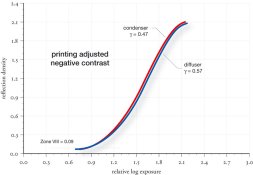BetterSense
Member
I have an Omega D2 for printing 4x5 negatives. I have a 135mm lens. I can just barely print an 8x10, if I loosen my lens several turns for more extension. Any smaller, and my bellows racks all the way out before I obtain focus. So if I want to print a 5x7 from 4x5 right now I can't.
My first instinct is "Oh, I need a longer lens, then the baseboard image will be smaller". But wouldn't a longerr lens need MORE bellows draw? Or would a longer lens force me to put the enlarger higher, paradoxically resulting in less bellows draw (real focal length)? This is confusing my brain.
Also, has anyone ever printed medium format and/or 35mm with the 4x5 condensers in place? I understand that they make special condensers for smaller formats but I'm having a hard time understanding why, considering that if it works for 4x5 it shouldn't work the same for 35mm, considering 35mm is basically a crop out of a 4x5 negative.
My first instinct is "Oh, I need a longer lens, then the baseboard image will be smaller". But wouldn't a longerr lens need MORE bellows draw? Or would a longer lens force me to put the enlarger higher, paradoxically resulting in less bellows draw (real focal length)? This is confusing my brain.
Also, has anyone ever printed medium format and/or 35mm with the 4x5 condensers in place? I understand that they make special condensers for smaller formats but I'm having a hard time understanding why, considering that if it works for 4x5 it shouldn't work the same for 35mm, considering 35mm is basically a crop out of a 4x5 negative.












